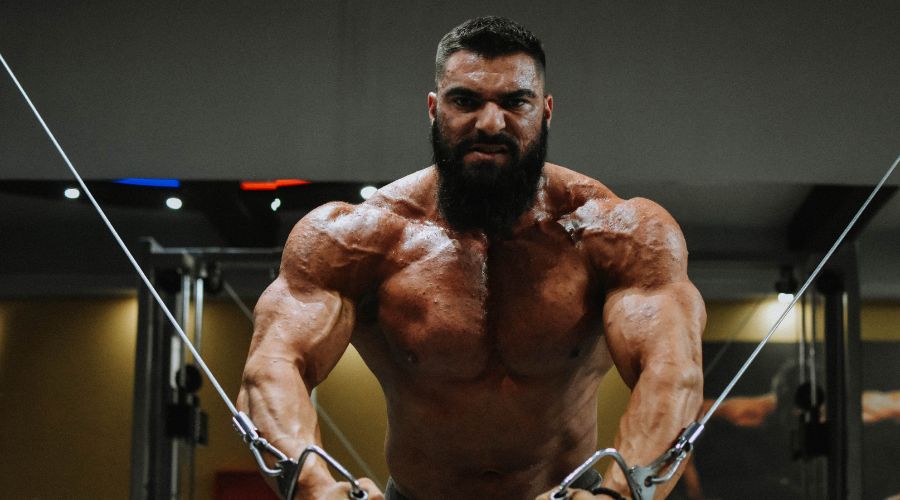Having a big, strong neck helps immensely in jiu-jitsu with injury prevention, better resistance to submissions, and withstanding attempts to break your posture through the head. Neglecting neck training is a grave mistake many practitioners make and one you should avoid. But what are the best neck exercises for BJJ?
A key part of neck training for BJJ is doing isometric holds, which directly translate to actions on the mat, like resisting pulling, pushing, and chokes. To make your neck bigger, you must do flexion and extension with progressive resistance using bands, weights, or other methods of loading the movements.
Neck training is crucial for BJJ, and I will help you pick the best exercises and avoid some dangerous ones that bring more risk than reward.
Why You Need A Strong Neck For Jiu-Jitsu
In a sport where the whole body plays a role, you are only as strong as your weakest link. The neck is a crucial element because it needs to resist constant pulling, is used as a support against the mats, and, most of all, is the target of half of the submissions in BJJ, namely strangulations.
This means the neck is as important as any other body part for jiu-jitsu, and a well-conditioned and robust neck will help you while rolling and in training in multiple ways.
Better Submission Defence
Resisting chokeholds is part technique, mental fortitude, and pure neck strength. Even if you’ve never trained your neck specifically, you know how bad it felt to be in a guillotine when you started and how much more “comfortable” you feel now. This is because the neck gets conditioned by the constant pressure it’s subjected to during drills and rolling.
Adding neck conditioning to your training regimen will hasten the process and reach levels of strength impossible with BJJ training alone.
The stronger your neck and upper back muscles are, the harder it will be for someone to choke you out. Increasing the size of the neck also makes chokes mechanically more difficult for the opponent.
Neck cranks are even worse, and a powerful neck may get you out of trouble because cranks aim to take your neck outside of its normal range of motion, and through strong musculature, you can resist the attempt.
That said, I advise you not to try and tough out tight-neck cranks because they can be dangerous and have dire consequences.
Resisting Attempts To Break Your Posture

When standing, pulling the head of the opponent from behind is one of the main methods of breaking their posture. Having a weak neck will make it a piece of cake to get folded in two.
But the neck is not used to manipulate positions and posture only on the feet. When you end up in someone’s guard, he will pull your head for dear life and not let you posture up.
It’s easy to understand how a strong neck will benefit you in every position where you must resist pulling and pushing, and isometric exercises are great at building resistance capacity.
Less Chance Of Injury
While you cannot prevent the occasional neck pain and some injuries, mobility and strength play a key role in injury prevention for most body parts, including the neck. The neck is often placed in extended ranges of motion under heavy force.
By training the neck in a full range of motion and with controlled resistance, you will prepare the soft tissues for the strain they must endure.
Best BJJ Neck Strengthening Exercises
Quite a few exercises can make the neck healthy and strong. For a complete package of strength and mobility, you need isometric holds, full range of motion exercises with resistance, and some static stretches after training.
Isometric Holds
Isometric strength is crucial for BJJ. Many of the actions during rolling require isometric tension, from takedown attempts to resisting collar ties. You can do four-way isometric holds using various equipment to prepare for this. Four-way holds mean resisting force from the front, back, left, and right.
Isometric holds can be done in a few ways. The first is by using rubber bands. Just tie the band to a post, step away at a sufficient distance, and hold.
A more accessible version, which you can do everywhere and every time, is using your hands. Just push in the respective direction with your hands and push in the opposite direction with your head.
Hold each for 10 to 30 seconds, depending on your strength. Start slowly and gradually increase the time and resistance. You can use bands, hands, or a neck harness for maximum resistance holds when you feel comfortable.
Neck Flexion And Extension With Resistance
One of the most popular exercises for neck strength is neck flexion and extension with a harness. This is what you’ve seen countless bodybuilders and fighters do. The exercise is executed by attaching a weight to a harness, nodding your head front and back, and lifting the weight with your head. The neck harness can also be used for isometric holds.
Using weight plates is another way of doing flexion, extension, and lateral flexion. This can be done with the help of a towel or with the aid of specially designed equipment like The Strong Neck. Lateral flexion is often neglected, but it’s also important because it mimics someone pushing your neck to the side.
Regular flexion and extension strengthen the ability to tuck your chin and resist someone pulling on the back of your head. Start with light weights in the beginning and gradually build up. For most people, up to 5 kg is more than enough to begin, with rep ranges between 10 and 20 reps.
You can also do the movements without any equipment but your hands. Just like with the isometric exercises, push against your head, but this time move the head through a full range of motion in all four directions.
Iron Neck Exercises
The Iron Neck is a neck training device combining everything in a single package. It is by far the most effective method of neck training because you can improve isometric neck strength and mobility simultaneously.
Then it provides resistance at a 360-degree angle, allowing you to perform 360-degree spins, diagonals, and figure eights, something no other piece of equipment can do.
Basically, the Iron Neck allows you to do all exercises better and more efficiently. You can read our full Iron Neck review here.
Neck Bridges
Neck bridges are hugely popular among wrestlers for a good reason. It will develop strong neck muscles, and wrestlers must be strong in the position because it’s part of the sport.
But neck bridges have been found to have a high risk of injury because of the compression force on the spine combined with the side-to-side force. They can lead to soft tissue damage, but the worst part is the possible damage to the disks and loosening of cervical spine ligaments.
So, while wrestlers must be able to bridge their heads to avoid being pinned and losing the match, for BJJ guys and every other combat athlete, the move brings too much risk for the rewards it offers. The exercises I’ve shown above are much safer and will yield the same results in the long run without the danger.
Does BJJ Make Your Neck Stronger?

BJJ will make your neck stronger, but not bigger. Even though the neck involves many grappling movements, most are isometric holds to resist grips and submissions.
The duration of these holds is usually not enough for a meaningful size increase, but they will make your neck stronger in these same positions.
You must lengthen and contract the muscles with enough volume and resistance to make your neck bigger and stronger. This can be done via bands, harnesses, free weights, or the Iron Neck.
Summary
Pay attention to neck muscles and conditioning. Spending the short time needed to exercise them will save you many instances of stiff necks and even bigger injuries while helping you resist your training partner’s and opponent’s submission attempts.
